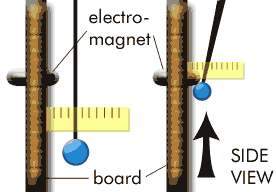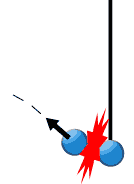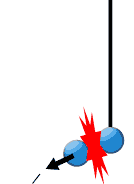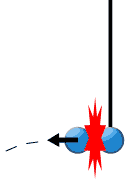N
otes on Chapter 7 B
pp 69 - 72 of your lab book
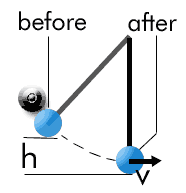
pp 69 - 72 of your lab book
- Potential energy is stored energy
- Gravitational potential energy is energy which an object has due to its position in a gravitational field (the space around any mass).
- Kinetic energy is energy which an object has due to its movement (velocity)
Conservation
of energy: the total energy of a system before = the total energy
of a system after
Total energy = potential energy + kinetic energy
The conservation of energy
tells you how much potential energy got converted into kinetic energy. This
conservation law is true provided no work was done. Work can be an energy
loss in your system due to friction, deformations as the object collides
with something else, or it can be an energy gain to your system such as wind.
(But remember the total energy of the entire universe is always conserved,
so although your system is losing energy, something else has to be gaining
energy!)Total energy = potential energy + kinetic energy
- The equation for gravitational potential energy (PE) = mgh, where m = mass of the object, g = the gravitational acceleration, and h = height
- The equation for kinetic energy (KE) = 1/2 mv2, where v = velocity.

In the picture
above, the pendulum is released from rest at a height h. We want to measure
the energy when the pendulum is at the lowest point in its swing, which
we will say is ground (height = 0 meters). Our conservation law is:
mgh
i + 1/2 mvi2 = mghf + 1/2 mv
f 2
mgh + 1/2 m(0 m/s)2= mg (0 meters) + 1/2 mv2
mgh = 1/2 mv2
Of course, energy is lost
to friction and to the collision. You can calculate the theoretical
D from your measurements of L and h, and that calculated D will always be
greater than the D which you observe.mgh + 1/2 m(0 m/s)2= mg (0 meters) + 1/2 mv2
mgh = 1/2 mv2
How do we
measure the velocity of the pendulum? In order to do this, we place a ball
in the path of the pendulum. The ball is of the same mass as the pendulum
bob, so the pendulum will give all its kinetic energy to the ball. We can
measure the velocity of the ball because the ball is a freely falling body,
and we know the equations of motion for that! If we know the distance it travels
before it lands and the height at which it started, then we can determine
the velocity at the beginning of the path, which is the same as the velocity
of the pendulum at the lowest point!
Putting all these facts together, we can come up with an equation for D, the distance the ball travels, in terms of L, the height that the ball is at relative to the floor, and h, the height of the pendulum bob. (See figure 7.4) We will derive this in class.
Putting all these facts together, we can come up with an equation for D, the distance the ball travels, in terms of L, the height that the ball is at relative to the floor, and h, the height of the pendulum bob. (See figure 7.4) We will derive this in class.
D2
= 4Lh

